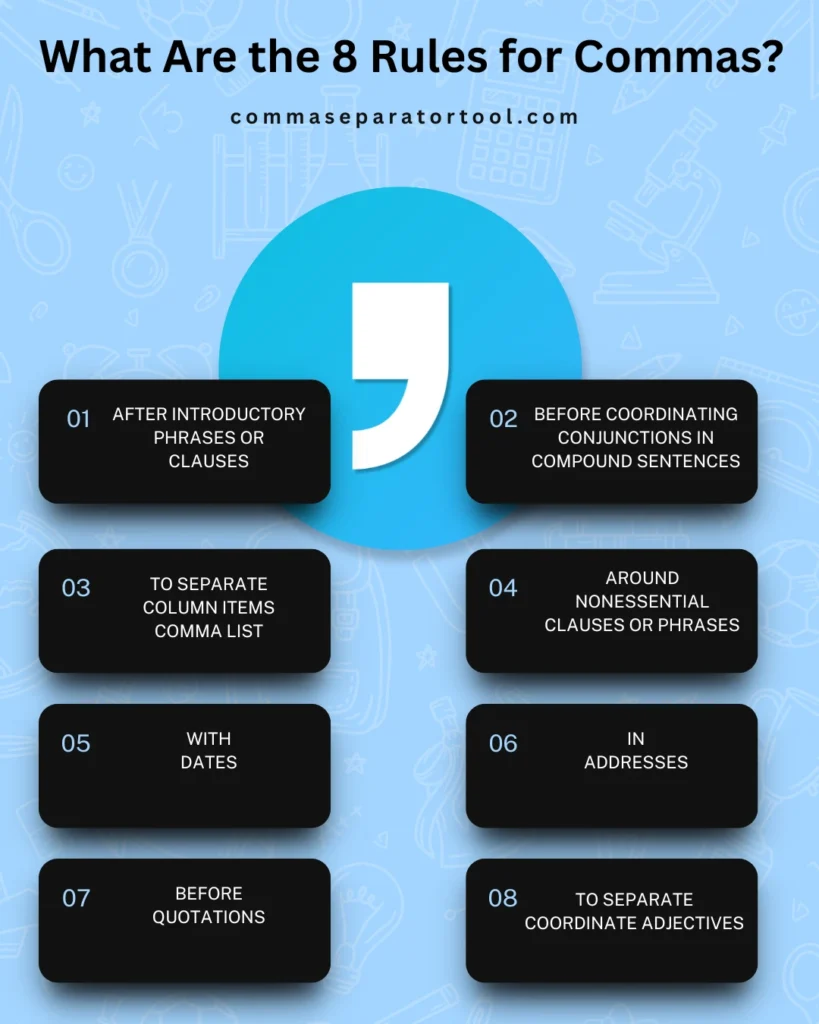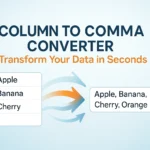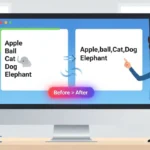“When to Use a Comma in a Sentence: using commas after introductory phrases, before coordinating conjunctions in compound sentences, to separate items in a list, and around nonessential clauses.”
Commas are the unsung heroes of clear and effective writing. Whether you’re writing a blog post, crafting an email, or drafting an essay, knowing When to Use a Comma in a Sentence correctly can make all the difference. Misplacing a comma can lead to confusion or even alter the meaning of a sentence entirely.
If you’ve ever wondered, “What is a comma, and When to Use a Comma in a Sentence?” or “What are the 8 rules for commas?”, you’re in the right place. This blog will provide you with simple explanations, examples, and even answer common questions about comma usage. By the end, you’ll wield this tiny punctuation mark with confidence.
Table of Contents
What Is a Comma?
A comma (,) is a punctuation mark that indicates a slight pause between parts of a sentence or separates items in a list. While commas might seem small and insignificant, they serve a critical function in structuring your writing and ensuring clarity.
For example:
- Without a comma: “Let’s eat Grandma.”
- With a comma: “Let’s eat, Grandma.”
See the difference? That little comma saved Grandma’s life (and avoided a very awkward dinner).
Now, let’s look at when you should use a comma in a sentence.
Want to apply this practically? See how commas are used in data formatting.
The 8 Essential Rules for When to Use a Comma in a Sentence

1. To Separate Items in a List
When you’re listing three or more items, commas help separate them for clarity.
Example: I bought apples, oranges, bananas, and grapes from the market.
This is where the Oxford comma comes into play. Some styles, like AP, skip the final comma before “and,” but using it can avoid ambiguity.
2. After Introductory Words or Phrases
Use a comma after introductory elements to signal that the main part of the sentence is beginning.
Example: After the meeting, we decided to grab lunch.
Pro Tip: Words like “However,” “Therefore,” “Meanwhile,” and “Additionally” often require a comma when they start a sentence.
3. Before a Coordinating Conjunction in a Compound Sentence
When joining two independent clauses with a coordinating conjunction (like and, but, or, so, for, nor, yet), use a comma before the conjunction.
Example: I wanted to go for a walk, but it started raining.
4. To Set Off Nonessential Information
If a clause, phrase, or word adds extra information without changing the sentence’s main meaning, use commas to ‘set it off.’
Example: My brother, who lives in New York, is visiting us this weekend.
Tip: Remove the nonessential element to check if the sentence still makes sense. If it does, you need commas.
5. Between Two Adjectives That Modify the Same Noun
If two adjectives equally describe a noun, separate them with a comma.
Example: It was a long, exhausting day.
Test: Try adding “and” between the adjectives. If it works, use a comma.
6. To Address Someone Directly
Whether you’re greeting someone or emphasizing their name mid-sentence, set the name off with commas.
Example 1: Good morning, Sarah.
Example 2: I hope, James, you’re enjoying the workshop.
7. With Dates and Locations
Commas separate days, months, years, and locations.
Example for Date: On September 5, 2023, we launched our website.
Example for Location: We visited Paris, France, during our vacation.
8. To Avoid Confusion
Sometimes, a comma is used simply for clarity.
Example: Instead of cooking, my sister ordered pizza.
Without the comma, the sentence could momentarily make it seem like “cooking my sister” is the plan!
When NOT to Use a Comma
Now that you’ve seen when to use commas, it’s equally important to know when NOT to use them. Avoid placing commas:
- Between a subject and verb (e.g., “The coffee on the table, is cold.” ❌).
- Between two verbs in a simple sentence (e.g., “She danced, and sang.” ❌).
- Before dependent clauses (e.g., “He left because, he was tired.” ❌).
Remember, overusing commas is just as bad as leaving them out.
When to Use a Comma in a Sentence FAQs
What is the purpose of a comma?
A comma adds pauses to sentences to make them more readable and to clarify meaning. It separates ideas, items in lists, and nonessential information.
What are the 8 rules for commas?
The main rules are for lists, introductory phrases, coordinating conjunctions, nonessential elements, multiple adjectives, direct address, dates/locations, and clarity. Check the explanations above for examples.
When should I use a semicolon instead of a comma?
Use a semicolon, not a comma, between two independent clauses if no coordinating conjunction is present.
Example with a semicolon: I wanted to go for a walk; however, it started raining.
Is there a worksheet to practice when to use commas in a sentence?
Yes! Many websites offer free downloadable worksheets. Try resources like Grammar Monster or Purdue OWL for interactive examples.
Are there comma rules for kids?
Absolutely. Teaching kids to use commas can start with simple rules, like using them in lists or dates. Short, visually engaging lessons work best for younger learners.
Why When to Use a Comma in a Sentence Matters
Commas are a small but mighty tool in writing. They can clarify meaning, elevate your style, and ensure your message is understood. Incorrect comma usage might confuse readers or distract from your incredible content. Whether you’re crafting a blog post, writing an essay, or communicating professionally, mastering commas will make your writing more polished and effective.
Start practicing these rules and revisiting tricky usage spots to become confident in your comma placements. Need more tips on punctuation? Explore additional resources on grammar and style.
Happy writing!











